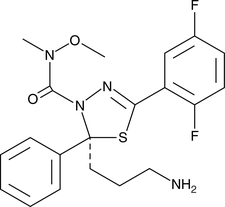Chemicals
Showing 9901–10050 of 41137 results
-
ARN14686 is an activity-based affinity probe for the detection of N-acylethanolamine acid amidase (NAAA) using click chemistry.{36895} It binds covalently to the N-terminal cysteine of catalytically active NAAA to form a thioester adduct. ARN14686 inhibits the hydrolysis of the NAAA substrate PAMCA in HEK293 cells (IC50s = 6 and 13 nM for human and rat recombinant enzymes, respectively) and is selective for NAAA over acid ceramidase (IC50 = 1,200 nM for the rat enzyme). It labels NAAA in HEK293 cells overexpressing human or rat recombinant NAAA and, when used at concentrations of 1 and 10 µM, in rat lung lysosomal fractions in vitro. It also detects NAAA in lung lysosomal fractions following intravenous administration at a dose of 10 mg/kg in rats. ARN14686 (3 mg/kg) has been used to determine that catalytically active NAAA is present in inflamed rat paw in a complete Freund’s adjuvant model of inflammation.{36896}
Brand:CaymanSKU:24261 - 1 mgAvailable on backorder
ARN14686 is an activity-based affinity probe for the detection of N-acylethanolamine acid amidase (NAAA) using click chemistry.{36895} It binds covalently to the N-terminal cysteine of catalytically active NAAA to form a thioester adduct. ARN14686 inhibits the hydrolysis of the NAAA substrate PAMCA in HEK293 cells (IC50s = 6 and 13 nM for human and rat recombinant enzymes, respectively) and is selective for NAAA over acid ceramidase (IC50 = 1,200 nM for the rat enzyme). It labels NAAA in HEK293 cells overexpressing human or rat recombinant NAAA and, when used at concentrations of 1 and 10 µM, in rat lung lysosomal fractions in vitro. It also detects NAAA in lung lysosomal fractions following intravenous administration at a dose of 10 mg/kg in rats. ARN14686 (3 mg/kg) has been used to determine that catalytically active NAAA is present in inflamed rat paw in a complete Freund’s adjuvant model of inflammation.{36896}
Brand:CaymanSKU:24261 - 10 mgAvailable on backorder
ARN14686 is an activity-based affinity probe for the detection of N-acylethanolamine acid amidase (NAAA) using click chemistry.{36895} It binds covalently to the N-terminal cysteine of catalytically active NAAA to form a thioester adduct. ARN14686 inhibits the hydrolysis of the NAAA substrate PAMCA in HEK293 cells (IC50s = 6 and 13 nM for human and rat recombinant enzymes, respectively) and is selective for NAAA over acid ceramidase (IC50 = 1,200 nM for the rat enzyme). It labels NAAA in HEK293 cells overexpressing human or rat recombinant NAAA and, when used at concentrations of 1 and 10 µM, in rat lung lysosomal fractions in vitro. It also detects NAAA in lung lysosomal fractions following intravenous administration at a dose of 10 mg/kg in rats. ARN14686 (3 mg/kg) has been used to determine that catalytically active NAAA is present in inflamed rat paw in a complete Freund’s adjuvant model of inflammation.{36896}
Brand:CaymanSKU:24261 - 25 mgAvailable on backorder
ARN14686 is an activity-based affinity probe for the detection of N-acylethanolamine acid amidase (NAAA) using click chemistry.{36895} It binds covalently to the N-terminal cysteine of catalytically active NAAA to form a thioester adduct. ARN14686 inhibits the hydrolysis of the NAAA substrate PAMCA in HEK293 cells (IC50s = 6 and 13 nM for human and rat recombinant enzymes, respectively) and is selective for NAAA over acid ceramidase (IC50 = 1,200 nM for the rat enzyme). It labels NAAA in HEK293 cells overexpressing human or rat recombinant NAAA and, when used at concentrations of 1 and 10 µM, in rat lung lysosomal fractions in vitro. It also detects NAAA in lung lysosomal fractions following intravenous administration at a dose of 10 mg/kg in rats. ARN14686 (3 mg/kg) has been used to determine that catalytically active NAAA is present in inflamed rat paw in a complete Freund’s adjuvant model of inflammation.{36896}
Brand:CaymanSKU:24261 - 5 mgAvailable on backorder
ARN14974 is a benzoxazolone carboxamide inhibitor of acid ceramidase (IC50 = 79 nM).{27811} It inhibits acid ceramidase activity, reduces levels of sphingosine and dihydroceramide, and increases levels of ceramide in SW403 adenocarcinoma cells and RAW 264.7 murine macrophages when used at concentrations ranging from 0.1 to 20 mM. In vivo, ARN14974 (10 mg/kg, i.v.) reduces acid ceramidase activity in multiple organs, including brain, liver, heart, lungs, and kidney, and increases pulmonary ceramide levels in mice.
Brand:CaymanSKU:-Out of stock
ARN14974 is a benzoxazolone carboxamide inhibitor of acid ceramidase (IC50 = 79 nM).{27811} It inhibits acid ceramidase activity, reduces levels of sphingosine and dihydroceramide, and increases levels of ceramide in SW403 adenocarcinoma cells and RAW 264.7 murine macrophages when used at concentrations ranging from 0.1 to 20 mM. In vivo, ARN14974 (10 mg/kg, i.v.) reduces acid ceramidase activity in multiple organs, including brain, liver, heart, lungs, and kidney, and increases pulmonary ceramide levels in mice.
Brand:CaymanSKU:-Out of stock
ARN14974 is a benzoxazolone carboxamide inhibitor of acid ceramidase (IC50 = 79 nM).{27811} It inhibits acid ceramidase activity, reduces levels of sphingosine and dihydroceramide, and increases levels of ceramide in SW403 adenocarcinoma cells and RAW 264.7 murine macrophages when used at concentrations ranging from 0.1 to 20 mM. In vivo, ARN14974 (10 mg/kg, i.v.) reduces acid ceramidase activity in multiple organs, including brain, liver, heart, lungs, and kidney, and increases pulmonary ceramide levels in mice.
Brand:CaymanSKU:-Out of stock
ARN14974 is a benzoxazolone carboxamide inhibitor of acid ceramidase (IC50 = 79 nM).{27811} It inhibits acid ceramidase activity, reduces levels of sphingosine and dihydroceramide, and increases levels of ceramide in SW403 adenocarcinoma cells and RAW 264.7 murine macrophages when used at concentrations ranging from 0.1 to 20 mM. In vivo, ARN14974 (10 mg/kg, i.v.) reduces acid ceramidase activity in multiple organs, including brain, liver, heart, lungs, and kidney, and increases pulmonary ceramide levels in mice.
Brand:CaymanSKU:-Out of stock
ARN14988 is a potent inhibitor of acid ceramidase (IC50 = 12.8 nM for the human enzyme).{40582} It inhibits acid ceramidase activity and increases levels of C16 dihydro ceramide (Item No. 24369) and C16 ceramide (Item No. 10681) in A375, G361, M14, MeWo, MNT-1, and SK-MEL-28 melanoma cells. ARN14988 also reduces growth of A375 and G361 melanoma cells (EC50s = 41.8 and 67.7 µM, respectively).
Brand:CaymanSKU:24284 - 1 mgAvailable on backorder
ARN14988 is a potent inhibitor of acid ceramidase (IC50 = 12.8 nM for the human enzyme).{40582} It inhibits acid ceramidase activity and increases levels of C16 dihydro ceramide (Item No. 24369) and C16 ceramide (Item No. 10681) in A375, G361, M14, MeWo, MNT-1, and SK-MEL-28 melanoma cells. ARN14988 also reduces growth of A375 and G361 melanoma cells (EC50s = 41.8 and 67.7 µM, respectively).
Brand:CaymanSKU:24284 - 10 mgAvailable on backorder
ARN14988 is a potent inhibitor of acid ceramidase (IC50 = 12.8 nM for the human enzyme).{40582} It inhibits acid ceramidase activity and increases levels of C16 dihydro ceramide (Item No. 24369) and C16 ceramide (Item No. 10681) in A375, G361, M14, MeWo, MNT-1, and SK-MEL-28 melanoma cells. ARN14988 also reduces growth of A375 and G361 melanoma cells (EC50s = 41.8 and 67.7 µM, respectively).
Brand:CaymanSKU:24284 - 25 mgAvailable on backorder
ARN14988 is a potent inhibitor of acid ceramidase (IC50 = 12.8 nM for the human enzyme).{40582} It inhibits acid ceramidase activity and increases levels of C16 dihydro ceramide (Item No. 24369) and C16 ceramide (Item No. 10681) in A375, G361, M14, MeWo, MNT-1, and SK-MEL-28 melanoma cells. ARN14988 also reduces growth of A375 and G361 melanoma cells (EC50s = 41.8 and 67.7 µM, respectively).
Brand:CaymanSKU:24284 - 5 mgAvailable on backorder
ARN19874 is an inhibitor of N-acyl phosphatidylethanolamine phospholipase D (NAPE-PLD; IC50 = 33.7 µM).{40567} It is selective for NAPD-PLD over carbonic anhydrase II, neutral endopeptidase, and angiotensin-converting enzyme (ACE) up to 50 µM. ARN19874 (50 µM) increases the levels of certain NAPE substrates and decreases the endogenous levels of stearoyl ethanolamide (Item No. 90245), but not oleoyl ethanolamide (Item No. 90265) or palmitoyl ethanolamide (Item No. 90350), in HEK293 cells.
Brand:CaymanSKU:24283 - 1 mgAvailable on backorder
ARN19874 is an inhibitor of N-acyl phosphatidylethanolamine phospholipase D (NAPE-PLD; IC50 = 33.7 µM).{40567} It is selective for NAPD-PLD over carbonic anhydrase II, neutral endopeptidase, and angiotensin-converting enzyme (ACE) up to 50 µM. ARN19874 (50 µM) increases the levels of certain NAPE substrates and decreases the endogenous levels of stearoyl ethanolamide (Item No. 90245), but not oleoyl ethanolamide (Item No. 90265) or palmitoyl ethanolamide (Item No. 90350), in HEK293 cells.
Brand:CaymanSKU:24283 - 10 mgAvailable on backorder
ARN19874 is an inhibitor of N-acyl phosphatidylethanolamine phospholipase D (NAPE-PLD; IC50 = 33.7 µM).{40567} It is selective for NAPD-PLD over carbonic anhydrase II, neutral endopeptidase, and angiotensin-converting enzyme (ACE) up to 50 µM. ARN19874 (50 µM) increases the levels of certain NAPE substrates and decreases the endogenous levels of stearoyl ethanolamide (Item No. 90245), but not oleoyl ethanolamide (Item No. 90265) or palmitoyl ethanolamide (Item No. 90350), in HEK293 cells.
Brand:CaymanSKU:24283 - 5 mgAvailable on backorder
ARN19874 is an inhibitor of N-acyl phosphatidylethanolamine phospholipase D (NAPE-PLD; IC50 = 33.7 µM).{40567} It is selective for NAPD-PLD over carbonic anhydrase II, neutral endopeptidase, and angiotensin-converting enzyme (ACE) up to 50 µM. ARN19874 (50 µM) increases the levels of certain NAPE substrates and decreases the endogenous levels of stearoyl ethanolamide (Item No. 90245), but not oleoyl ethanolamide (Item No. 90265) or palmitoyl ethanolamide (Item No. 90350), in HEK293 cells.
Brand:CaymanSKU:24283 - 500 µgAvailable on backorder
ARN3236 is an inhibitor of salt-inducible kinase 2 (SIK2; IC50 = 50s = 21.63 and 6.63 nM, respectively). It inhibits TNF-α secretion in RAW 264.7 cells (IC50 = ~2.5 µM) and reduces phosphorylation of the SIK2 targets CRTC3 and HDAC4 in macrophages when used at a concentration of 3 µM. ARN3236 inhibits growth of 10 ovarian cancer cell lines (IC50s = 0.8-2.6 µM) and increases the sensitivity of eight of them to paclitaxel (Item No. 10461).{54419} It halts the cell cycle at the G2/M phase and induces apoptosis and tetraploidy in SKOV3 cells when used at a concentration of 1 µM. ARN3236 (60 mg/kg per day) has an additive effect on reducing tumor growth when used in combination with paclitaxel in an ovarian cancer mouse xenograft model.
Brand:CaymanSKU:31457 - 1 mgAvailable on backorder
ARN3236 is an inhibitor of salt-inducible kinase 2 (SIK2; IC50 = 50s = 21.63 and 6.63 nM, respectively). It inhibits TNF-α secretion in RAW 264.7 cells (IC50 = ~2.5 µM) and reduces phosphorylation of the SIK2 targets CRTC3 and HDAC4 in macrophages when used at a concentration of 3 µM. ARN3236 inhibits growth of 10 ovarian cancer cell lines (IC50s = 0.8-2.6 µM) and increases the sensitivity of eight of them to paclitaxel (Item No. 10461).{54419} It halts the cell cycle at the G2/M phase and induces apoptosis and tetraploidy in SKOV3 cells when used at a concentration of 1 µM. ARN3236 (60 mg/kg per day) has an additive effect on reducing tumor growth when used in combination with paclitaxel in an ovarian cancer mouse xenograft model.
Brand:CaymanSKU:31457 - 10 mgAvailable on backorder
ARN3236 is an inhibitor of salt-inducible kinase 2 (SIK2; IC50 = 50s = 21.63 and 6.63 nM, respectively). It inhibits TNF-α secretion in RAW 264.7 cells (IC50 = ~2.5 µM) and reduces phosphorylation of the SIK2 targets CRTC3 and HDAC4 in macrophages when used at a concentration of 3 µM. ARN3236 inhibits growth of 10 ovarian cancer cell lines (IC50s = 0.8-2.6 µM) and increases the sensitivity of eight of them to paclitaxel (Item No. 10461).{54419} It halts the cell cycle at the G2/M phase and induces apoptosis and tetraploidy in SKOV3 cells when used at a concentration of 1 µM. ARN3236 (60 mg/kg per day) has an additive effect on reducing tumor growth when used in combination with paclitaxel in an ovarian cancer mouse xenograft model.
Brand:CaymanSKU:31457 - 25 mgAvailable on backorder
ARN3236 is an inhibitor of salt-inducible kinase 2 (SIK2; IC50 = 50s = 21.63 and 6.63 nM, respectively). It inhibits TNF-α secretion in RAW 264.7 cells (IC50 = ~2.5 µM) and reduces phosphorylation of the SIK2 targets CRTC3 and HDAC4 in macrophages when used at a concentration of 3 µM. ARN3236 inhibits growth of 10 ovarian cancer cell lines (IC50s = 0.8-2.6 µM) and increases the sensitivity of eight of them to paclitaxel (Item No. 10461).{54419} It halts the cell cycle at the G2/M phase and induces apoptosis and tetraploidy in SKOV3 cells when used at a concentration of 1 µM. ARN3236 (60 mg/kg per day) has an additive effect on reducing tumor growth when used in combination with paclitaxel in an ovarian cancer mouse xenograft model.
Brand:CaymanSKU:31457 - 5 mgAvailable on backorder
ARN726 is an inhibitor of N-acylethanolamine acid amidase (NAAA; IC50s = 27 and 63 nM for the human and rat enzyme, respectively).{50197} It is selective for NAAA over fatty acid amide hydrolase (FAAH) and acid ceramidase (IC50s = >100 and 12.5 μM, respectively), as well as a panel of 28 lipid metabolism- and inflammation-related enzymes at 10 μM. ARN726 (1-30 mg/kg) decreases lung myeloperoxidase activity and pleural exudate TNF-α levels in a mouse model of carrageenan-induced lung inflammation. It inhibits NAAA and reverses complete Freund’s adjuvant-induced decreases in palmitoyl ethanolamide (PEA; Item No. 90350) and oleoyl ethanolamide (OEA; Item No. 90265) levels in inflamed paw tissue in a rat model of arthritis.{36896}
Brand:CaymanSKU:24259 - 1 mgAvailable on backorder
ARN726 is an inhibitor of N-acylethanolamine acid amidase (NAAA; IC50s = 27 and 63 nM for the human and rat enzyme, respectively).{50197} It is selective for NAAA over fatty acid amide hydrolase (FAAH) and acid ceramidase (IC50s = >100 and 12.5 μM, respectively), as well as a panel of 28 lipid metabolism- and inflammation-related enzymes at 10 μM. ARN726 (1-30 mg/kg) decreases lung myeloperoxidase activity and pleural exudate TNF-α levels in a mouse model of carrageenan-induced lung inflammation. It inhibits NAAA and reverses complete Freund’s adjuvant-induced decreases in palmitoyl ethanolamide (PEA; Item No. 90350) and oleoyl ethanolamide (OEA; Item No. 90265) levels in inflamed paw tissue in a rat model of arthritis.{36896}
Brand:CaymanSKU:24259 - 10 mgAvailable on backorder
ARN726 is an inhibitor of N-acylethanolamine acid amidase (NAAA; IC50s = 27 and 63 nM for the human and rat enzyme, respectively).{50197} It is selective for NAAA over fatty acid amide hydrolase (FAAH) and acid ceramidase (IC50s = >100 and 12.5 μM, respectively), as well as a panel of 28 lipid metabolism- and inflammation-related enzymes at 10 μM. ARN726 (1-30 mg/kg) decreases lung myeloperoxidase activity and pleural exudate TNF-α levels in a mouse model of carrageenan-induced lung inflammation. It inhibits NAAA and reverses complete Freund’s adjuvant-induced decreases in palmitoyl ethanolamide (PEA; Item No. 90350) and oleoyl ethanolamide (OEA; Item No. 90265) levels in inflamed paw tissue in a rat model of arthritis.{36896}
Brand:CaymanSKU:24259 - 25 mgAvailable on backorder
ARN726 is an inhibitor of N-acylethanolamine acid amidase (NAAA; IC50s = 27 and 63 nM for the human and rat enzyme, respectively).{50197} It is selective for NAAA over fatty acid amide hydrolase (FAAH) and acid ceramidase (IC50s = >100 and 12.5 μM, respectively), as well as a panel of 28 lipid metabolism- and inflammation-related enzymes at 10 μM. ARN726 (1-30 mg/kg) decreases lung myeloperoxidase activity and pleural exudate TNF-α levels in a mouse model of carrageenan-induced lung inflammation. It inhibits NAAA and reverses complete Freund’s adjuvant-induced decreases in palmitoyl ethanolamide (PEA; Item No. 90350) and oleoyl ethanolamide (OEA; Item No. 90265) levels in inflamed paw tissue in a rat model of arthritis.{36896}
Brand:CaymanSKU:24259 - 5 mgAvailable on backorder
ARN810 is a selective estrogen receptor degrader (SERD) that binds to ERα and ERβ (IC50s = 6.1 and 8.8 nM, respectively) and induces degradation of ERα in MCF-7 cells (EC50 = 0.7 nM).{53182} It inhibits ERα transcriptional activity induced by 17β-estradiol (Item No. 10006315) in a reporter assay and reduces MCF-7 breast cancer cell viability (IC50 = 2 nM). ARN810 (1 mg/kg, p.o.) inhibits 17β-estradiol-induced uterine weight gain in rats. It reduces tumor volume in tamoxifen-sensitive and -resistant MCF-7 mouse xenograft models in a dose-dependent manner.
Brand:CaymanSKU:29595 - 1 mgAvailable on backorder
ARN810 is a selective estrogen receptor degrader (SERD) that binds to ERα and ERβ (IC50s = 6.1 and 8.8 nM, respectively) and induces degradation of ERα in MCF-7 cells (EC50 = 0.7 nM).{53182} It inhibits ERα transcriptional activity induced by 17β-estradiol (Item No. 10006315) in a reporter assay and reduces MCF-7 breast cancer cell viability (IC50 = 2 nM). ARN810 (1 mg/kg, p.o.) inhibits 17β-estradiol-induced uterine weight gain in rats. It reduces tumor volume in tamoxifen-sensitive and -resistant MCF-7 mouse xenograft models in a dose-dependent manner.
Brand:CaymanSKU:29595 - 10 mgAvailable on backorder
ARN810 is a selective estrogen receptor degrader (SERD) that binds to ERα and ERβ (IC50s = 6.1 and 8.8 nM, respectively) and induces degradation of ERα in MCF-7 cells (EC50 = 0.7 nM).{53182} It inhibits ERα transcriptional activity induced by 17β-estradiol (Item No. 10006315) in a reporter assay and reduces MCF-7 breast cancer cell viability (IC50 = 2 nM). ARN810 (1 mg/kg, p.o.) inhibits 17β-estradiol-induced uterine weight gain in rats. It reduces tumor volume in tamoxifen-sensitive and -resistant MCF-7 mouse xenograft models in a dose-dependent manner.
Brand:CaymanSKU:29595 - 25 mgAvailable on backorder
ARN810 is a selective estrogen receptor degrader (SERD) that binds to ERα and ERβ (IC50s = 6.1 and 8.8 nM, respectively) and induces degradation of ERα in MCF-7 cells (EC50 = 0.7 nM).{53182} It inhibits ERα transcriptional activity induced by 17β-estradiol (Item No. 10006315) in a reporter assay and reduces MCF-7 breast cancer cell viability (IC50 = 2 nM). ARN810 (1 mg/kg, p.o.) inhibits 17β-estradiol-induced uterine weight gain in rats. It reduces tumor volume in tamoxifen-sensitive and -resistant MCF-7 mouse xenograft models in a dose-dependent manner.
Brand:CaymanSKU:29595 - 5 mgAvailable on backorder
Matrix metalloproteinases (MMPs) belong to a family of proteases that play a crucial role in tissue remodeling and repair by degrading extracellular matrix proteins to enable cell migration.{16569} During cancer progression both MMP-2 and MMP-9 play a role in metastatic tumor dispersion and angiogenesis. ARP 100 is a biphenylsulfonamide that acts as a selective inhibitor of MMP-2 demonstrating an IC50 value of 12 nM.{17394,17393} Due to its specific zinc binding domain configuration, the inhibitory activity of ARP 100 is significantly less potent towards MMP-1, MMP-3, MMP-7, and MMP-9 (IC50 values are 50, 4.5, 50, and 2 µM, respectively).{17394,17393} At 50 nM, ARP 100 suppresses the invasive behavior of HT1080 tumor cells grown on matrigel.{17394}
Brand:CaymanSKU:-Matrix metalloproteinases (MMPs) belong to a family of proteases that play a crucial role in tissue remodeling and repair by degrading extracellular matrix proteins to enable cell migration.{16569} During cancer progression both MMP-2 and MMP-9 play a role in metastatic tumor dispersion and angiogenesis. ARP 100 is a biphenylsulfonamide that acts as a selective inhibitor of MMP-2 demonstrating an IC50 value of 12 nM.{17394,17393} Due to its specific zinc binding domain configuration, the inhibitory activity of ARP 100 is significantly less potent towards MMP-1, MMP-3, MMP-7, and MMP-9 (IC50 values are 50, 4.5, 50, and 2 µM, respectively).{17394,17393} At 50 nM, ARP 100 suppresses the invasive behavior of HT1080 tumor cells grown on matrigel.{17394}
Brand:CaymanSKU:-Matrix metalloproteinases (MMPs) belong to a family of proteases that play a crucial role in tissue remodeling and repair by degrading extracellular matrix proteins to enable cell migration.{16569} During cancer progression both MMP-2 and MMP-9 play a role in metastatic tumor dispersion and angiogenesis. ARP 100 is a biphenylsulfonamide that acts as a selective inhibitor of MMP-2 demonstrating an IC50 value of 12 nM.{17394,17393} Due to its specific zinc binding domain configuration, the inhibitory activity of ARP 100 is significantly less potent towards MMP-1, MMP-3, MMP-7, and MMP-9 (IC50 values are 50, 4.5, 50, and 2 µM, respectively).{17394,17393} At 50 nM, ARP 100 suppresses the invasive behavior of HT1080 tumor cells grown on matrigel.{17394}
Brand:CaymanSKU:-Aminopeptidase B is a Zn2+-dependent exopeptidase that selectively removes arginine and/or lysine from the amino terminus of peptide substrates.{29942} This enzyme is a metalloprotease commonly found on the surface of mammalian cells, including macrophages and lymphocytes. Arphamenine B is an aminopeptidase B inhibitor first isolated from bacteria.{29946,29945} Like the aminopeptidase inhibitors bestatin (Item No. 70520) and amastatin (Item No. 16719), arphamenine B enhances immune responses.{29946} Arphamenine B is commonly used to characterize novel proteases.{29943,29944}
Brand:CaymanSKU:-Available on backorder
Aminopeptidase B is a Zn2+-dependent exopeptidase that selectively removes arginine and/or lysine from the amino terminus of peptide substrates.{29942} This enzyme is a metalloprotease commonly found on the surface of mammalian cells, including macrophages and lymphocytes. Arphamenine B is an aminopeptidase B inhibitor first isolated from bacteria.{29946,29945} Like the aminopeptidase inhibitors bestatin (Item No. 70520) and amastatin (Item No. 16719), arphamenine B enhances immune responses.{29946} Arphamenine B is commonly used to characterize novel proteases.{29943,29944}
Brand:CaymanSKU:-Available on backorder
Aminopeptidase B is a Zn2+-dependent exopeptidase that selectively removes arginine and/or lysine from the amino terminus of peptide substrates.{29942} This enzyme is a metalloprotease commonly found on the surface of mammalian cells, including macrophages and lymphocytes. Arphamenine B is an aminopeptidase B inhibitor first isolated from bacteria.{29946,29945} Like the aminopeptidase inhibitors bestatin (Item No. 70520) and amastatin (Item No. 16719), arphamenine B enhances immune responses.{29946} Arphamenine B is commonly used to characterize novel proteases.{29943,29944}
Brand:CaymanSKU:-Available on backorder
ARQ-092 is an allosteric, orally bioavailable, pan-Akt inhibitor (IC50s = 5.0, 4.5, and 16 nM for Akt1, Akt2, and Akt3, respectively).{33792} It is selective for Akt isoforms over a panel of 303 other kinases.{33792} ARQ-092 binds inactive Akt and prevents membrane localization and full Akt activation.{33792,33790} It also directly inhibits the membrane-associated active form of Akt, preventing phosphorylation of downstream targets.{33792,33790} ARQ-092 inhibits the proliferation of a wide range of cancer cells in vitro, inhibits the mutated Akt form found in Proteus syndrome, and attenuates heterotypic cell-cell interactions in a mouse model of sickle cell disease.{33792,33790,32947,33791}
Brand:CaymanSKU:21388 -Out of stock
ARQ-092 is an allosteric, orally bioavailable, pan-Akt inhibitor (IC50s = 5.0, 4.5, and 16 nM for Akt1, Akt2, and Akt3, respectively).{33792} It is selective for Akt isoforms over a panel of 303 other kinases.{33792} ARQ-092 binds inactive Akt and prevents membrane localization and full Akt activation.{33792,33790} It also directly inhibits the membrane-associated active form of Akt, preventing phosphorylation of downstream targets.{33792,33790} ARQ-092 inhibits the proliferation of a wide range of cancer cells in vitro, inhibits the mutated Akt form found in Proteus syndrome, and attenuates heterotypic cell-cell interactions in a mouse model of sickle cell disease.{33792,33790,32947,33791}
Brand:CaymanSKU:21388 -Out of stock
ARQ-092 is an allosteric, orally bioavailable, pan-Akt inhibitor (IC50s = 5.0, 4.5, and 16 nM for Akt1, Akt2, and Akt3, respectively).{33792} It is selective for Akt isoforms over a panel of 303 other kinases.{33792} ARQ-092 binds inactive Akt and prevents membrane localization and full Akt activation.{33792,33790} It also directly inhibits the membrane-associated active form of Akt, preventing phosphorylation of downstream targets.{33792,33790} ARQ-092 inhibits the proliferation of a wide range of cancer cells in vitro, inhibits the mutated Akt form found in Proteus syndrome, and attenuates heterotypic cell-cell interactions in a mouse model of sickle cell disease.{33792,33790,32947,33791}
Brand:CaymanSKU:21388 -Out of stock
ARQ-092 is an allosteric, orally bioavailable, pan-Akt inhibitor (IC50s = 5.0, 4.5, and 16 nM for Akt1, Akt2, and Akt3, respectively).{33792} It is selective for Akt isoforms over a panel of 303 other kinases.{33792} ARQ-092 binds inactive Akt and prevents membrane localization and full Akt activation.{33792,33790} It also directly inhibits the membrane-associated active form of Akt, preventing phosphorylation of downstream targets.{33792,33790} ARQ-092 inhibits the proliferation of a wide range of cancer cells in vitro, inhibits the mutated Akt form found in Proteus syndrome, and attenuates heterotypic cell-cell interactions in a mouse model of sickle cell disease.{33792,33790,32947,33791}
Brand:CaymanSKU:21388 -Out of stock
Brand:CaymanSKU:24186 - 1 mgAvailable on backorder
Brand:CaymanSKU:24186 - 10 mgAvailable on backorder
Brand:CaymanSKU:24186 - 25 mgAvailable on backorder
Brand:CaymanSKU:24186 - 5 mgAvailable on backorder
ARRY-520 is a potent inhibitor of the kinesin spindle protein Eg5 (IC50 = 6 nM).{42111} It is selective for Eg5 over a panel of 8 kinesins (IC50s = >100 μM) and a panel of 224 kinases at a concentration of 10 μM. ARRY-520 induces time-and dose-dependent cell death in HL-60, Jurkat, OCI-AML3, U937, and MOLM-13 leukemic cells.{42112} Downregulation of Eg5 expression sensitizes HL-60 cells to ARRY-520 (IC50s = 11.3 and 2 nM for wild-type and Eg5 knockdown HL-60 cells, respectively). ARRY-520 induces cell cycle arrest at the G2/M phase in a p53- and XIAP-independent manner in OCI-AML3 cells. It also inhibits blast colony formation of bone marrow samples derived from human acute myeloid leukemia (AML) patients. In vivo, ARRY-520 (20 mg/kg per day) completely eliminates tumors in the RPMI-8226 multiple myeloma and HL-60 and MV4-11 AML mouse xenograft models.{42111}
Brand:CaymanSKU:21883 -Out of stock
ARRY-520 is a potent inhibitor of the kinesin spindle protein Eg5 (IC50 = 6 nM).{42111} It is selective for Eg5 over a panel of 8 kinesins (IC50s = >100 μM) and a panel of 224 kinases at a concentration of 10 μM. ARRY-520 induces time-and dose-dependent cell death in HL-60, Jurkat, OCI-AML3, U937, and MOLM-13 leukemic cells.{42112} Downregulation of Eg5 expression sensitizes HL-60 cells to ARRY-520 (IC50s = 11.3 and 2 nM for wild-type and Eg5 knockdown HL-60 cells, respectively). ARRY-520 induces cell cycle arrest at the G2/M phase in a p53- and XIAP-independent manner in OCI-AML3 cells. It also inhibits blast colony formation of bone marrow samples derived from human acute myeloid leukemia (AML) patients. In vivo, ARRY-520 (20 mg/kg per day) completely eliminates tumors in the RPMI-8226 multiple myeloma and HL-60 and MV4-11 AML mouse xenograft models.{42111}
Brand:CaymanSKU:21883 -Out of stock
ARRY-520 is a potent inhibitor of the kinesin spindle protein Eg5 (IC50 = 6 nM).{42111} It is selective for Eg5 over a panel of 8 kinesins (IC50s = >100 μM) and a panel of 224 kinases at a concentration of 10 μM. ARRY-520 induces time-and dose-dependent cell death in HL-60, Jurkat, OCI-AML3, U937, and MOLM-13 leukemic cells.{42112} Downregulation of Eg5 expression sensitizes HL-60 cells to ARRY-520 (IC50s = 11.3 and 2 nM for wild-type and Eg5 knockdown HL-60 cells, respectively). ARRY-520 induces cell cycle arrest at the G2/M phase in a p53- and XIAP-independent manner in OCI-AML3 cells. It also inhibits blast colony formation of bone marrow samples derived from human acute myeloid leukemia (AML) patients. In vivo, ARRY-520 (20 mg/kg per day) completely eliminates tumors in the RPMI-8226 multiple myeloma and HL-60 and MV4-11 AML mouse xenograft models.{42111}
Brand:CaymanSKU:21883 -Out of stock
ARRY-520 is a potent inhibitor of the kinesin spindle protein Eg5 (IC50 = 6 nM).{42111} It is selective for Eg5 over a panel of 8 kinesins (IC50s = >100 μM) and a panel of 224 kinases at a concentration of 10 μM. ARRY-520 induces time-and dose-dependent cell death in HL-60, Jurkat, OCI-AML3, U937, and MOLM-13 leukemic cells.{42112} Downregulation of Eg5 expression sensitizes HL-60 cells to ARRY-520 (IC50s = 11.3 and 2 nM for wild-type and Eg5 knockdown HL-60 cells, respectively). ARRY-520 induces cell cycle arrest at the G2/M phase in a p53- and XIAP-independent manner in OCI-AML3 cells. It also inhibits blast colony formation of bone marrow samples derived from human acute myeloid leukemia (AML) patients. In vivo, ARRY-520 (20 mg/kg per day) completely eliminates tumors in the RPMI-8226 multiple myeloma and HL-60 and MV4-11 AML mouse xenograft models.{42111}
Brand:CaymanSKU:21883 -Out of stock
ARS1620 is a covalent inhibitor of K-RASG12C (IC50 = G12C (IC50s = 150 nM) over H441, A549, and HCT116 cells expressing wild-type K-RAS (IC50s = >10 μM). ARS1620 (200 mg/kg) induces tumor regression in a MIA-PaCa2, but not an H441, mouse xenograft model. It also decreases tumor volume in patient-derived xenograft (PDX) mouse models expressing K-RASG12C, but not K-RASG12D or wild-type K-RAS.
Brand:CaymanSKU:27915 - 1 mgAvailable on backorder
ARS1620 is a covalent inhibitor of K-RASG12C (IC50 = G12C (IC50s = 150 nM) over H441, A549, and HCT116 cells expressing wild-type K-RAS (IC50s = >10 μM). ARS1620 (200 mg/kg) induces tumor regression in a MIA-PaCa2, but not an H441, mouse xenograft model. It also decreases tumor volume in patient-derived xenograft (PDX) mouse models expressing K-RASG12C, but not K-RASG12D or wild-type K-RAS.
Brand:CaymanSKU:27915 - 5 mgAvailable on backorder
ARS853 is an inhibitor of K-RASG12C, a mutant form of K-RAS that accumulates in the active GTP-bound state in certain cancer cells.{30527} ARS853 binds to the inactive GDP-bound state of K-RASG12C. It decreases the level of active GTP-bound K-RAS by 95% when used at a concentration of 10 µM in K-RASG12C mutant lung cancer cells. It also decreases phosphorylation of c-RAF, ERK, and Akt. ARS853 inhibits proliferation of six lung cancer cell lines containing the K-RASG12C mutation, including H358 cells (IC50 = 2.5 µM), but does not inhibit proliferation of PC-9 cells, which contain wild-type K-RAS.
Brand:CaymanSKU:-Available on backorder
ARS853 is an inhibitor of K-RASG12C, a mutant form of K-RAS that accumulates in the active GTP-bound state in certain cancer cells.{30527} ARS853 binds to the inactive GDP-bound state of K-RASG12C. It decreases the level of active GTP-bound K-RAS by 95% when used at a concentration of 10 µM in K-RASG12C mutant lung cancer cells. It also decreases phosphorylation of c-RAF, ERK, and Akt. ARS853 inhibits proliferation of six lung cancer cell lines containing the K-RASG12C mutation, including H358 cells (IC50 = 2.5 µM), but does not inhibit proliferation of PC-9 cells, which contain wild-type K-RAS.
Brand:CaymanSKU:-Available on backorder
ARS853 is an inhibitor of K-RASG12C, a mutant form of K-RAS that accumulates in the active GTP-bound state in certain cancer cells.{30527} ARS853 binds to the inactive GDP-bound state of K-RASG12C. It decreases the level of active GTP-bound K-RAS by 95% when used at a concentration of 10 µM in K-RASG12C mutant lung cancer cells. It also decreases phosphorylation of c-RAF, ERK, and Akt. ARS853 inhibits proliferation of six lung cancer cell lines containing the K-RASG12C mutation, including H358 cells (IC50 = 2.5 µM), but does not inhibit proliferation of PC-9 cells, which contain wild-type K-RAS.
Brand:CaymanSKU:-Available on backorder
ARS853 is an inhibitor of K-RASG12C, a mutant form of K-RAS that accumulates in the active GTP-bound state in certain cancer cells.{30527} ARS853 binds to the inactive GDP-bound state of K-RASG12C. It decreases the level of active GTP-bound K-RAS by 95% when used at a concentration of 10 µM in K-RASG12C mutant lung cancer cells. It also decreases phosphorylation of c-RAF, ERK, and Akt. ARS853 inhibits proliferation of six lung cancer cell lines containing the K-RASG12C mutation, including H358 cells (IC50 = 2.5 µM), but does not inhibit proliferation of PC-9 cells, which contain wild-type K-RAS.
Brand:CaymanSKU:-Available on backorder
Arteether is a derivative of the antimalarial drug artemisinin (Item No. 11816). Arteether inhibits P. falciparum with an IC50 value of 1.27 nM in vitro.{39374} It is effective against various strains of P. berghei in mice with ED90 values of 0.5-8.2 nM.
Brand:CaymanSKU:11814 - 10 mgAvailable on backorder
Arteether is a derivative of the antimalarial drug artemisinin (Item No. 11816). Arteether inhibits P. falciparum with an IC50 value of 1.27 nM in vitro.{39374} It is effective against various strains of P. berghei in mice with ED90 values of 0.5-8.2 nM.
Brand:CaymanSKU:11814 - 25 mgAvailable on backorder
Arteether is a derivative of the antimalarial drug artemisinin (Item No. 11816). Arteether inhibits P. falciparum with an IC50 value of 1.27 nM in vitro.{39374} It is effective against various strains of P. berghei in mice with ED90 values of 0.5-8.2 nM.
Brand:CaymanSKU:11814 - 5 mgAvailable on backorder
Arteether is a derivative of the antimalarial drug artemisinin (Item No. 11816). Arteether inhibits P. falciparum with an IC50 value of 1.27 nM in vitro.{39374} It is effective against various strains of P. berghei in mice with ED90 values of 0.5-8.2 nM.
Brand:CaymanSKU:11814 - 50 mgAvailable on backorder
Artefenomel is an ozonide antimalarial agent.{52714} It is active against 3D7, Cam3.II, and Cam3.II_rev P. falciparum strains (LC50s = 8.7, 4.4, and 6.1 nM, respectively). Artefenomel reduces the number of trophozoites in P. falciparum-infected isolated human red blood cells (IC50 = 31 nM).{52715} In vivo, artefenomel (30 mg/kg) is 100% curative in a mouse model of P. berghei infection.{52716}
Brand:CaymanSKU:30677 - 1 mgAvailable on backorder
Artefenomel is an ozonide antimalarial agent.{52714} It is active against 3D7, Cam3.II, and Cam3.II_rev P. falciparum strains (LC50s = 8.7, 4.4, and 6.1 nM, respectively). Artefenomel reduces the number of trophozoites in P. falciparum-infected isolated human red blood cells (IC50 = 31 nM).{52715} In vivo, artefenomel (30 mg/kg) is 100% curative in a mouse model of P. berghei infection.{52716}
Brand:CaymanSKU:30677 - 5 mgAvailable on backorder
Artemether is an antiparasitic compound and a derivative of artemisinin (Item No. 11816).{48487} It induces mortality in adult wild-type and pfatp6-mutant P. falciparum but the efficacy is decreased in the mutants (IC50s = 8.2 and 13.5 nM, respectively).{48485} Artemether reduces parasitemia in P. falciparum-infected monkeys and P. berghei-infected mice with 50% curative dose (CD50) values of 7.1 and 55 mg/kg, respectively.{48486} It also reduces the worm burden of S. mansoni trematodes in mice when used at doses ranging from 200 to 500 mg/kg.{48487} Formulations containing artemether have been used in the treatment of malaria.
Brand:CaymanSKU:11815 - 1 gAvailable on backorder
Artemether is an antiparasitic compound and a derivative of artemisinin (Item No. 11816).{48487} It induces mortality in adult wild-type and pfatp6-mutant P. falciparum but the efficacy is decreased in the mutants (IC50s = 8.2 and 13.5 nM, respectively).{48485} Artemether reduces parasitemia in P. falciparum-infected monkeys and P. berghei-infected mice with 50% curative dose (CD50) values of 7.1 and 55 mg/kg, respectively.{48486} It also reduces the worm burden of S. mansoni trematodes in mice when used at doses ranging from 200 to 500 mg/kg.{48487} Formulations containing artemether have been used in the treatment of malaria.
Brand:CaymanSKU:11815 - 500 mgAvailable on backorder
Artemether-d3 is intended for use as an internal standard for the quantification of artemether (Item No. 11815) by GC- or LC-MS. Artemether is an antiparasitic agent and a derivative of artemisinin (Item No. 11816).{48487} It induces mortality in adult wild-type and pfatp6-mutant P. falciparum but the efficacy is decreased in the mutants (IC50s = 8.2 and 13.5 nM, respectively).{48485} Artemether reduces parasitemia in P. falciparum-infected monkeys and P. berghei-infected mice with 50% curative dose (CD50) values of 7.1 and 55 mg/kg, respectively.{48486} It also reduces the worm burden of S. mansoni trematodes in mice when used at doses ranging from 200 to 500 mg/kg.{48487} Formulations containing artemether have been used in the treatment of malaria.
Brand:CaymanSKU:28517 - 1 mgAvailable on backorder
Artemether-d3 is intended for use as an internal standard for the quantification of artemether (Item No. 11815) by GC- or LC-MS. Artemether is an antiparasitic agent and a derivative of artemisinin (Item No. 11816).{48487} It induces mortality in adult wild-type and pfatp6-mutant P. falciparum but the efficacy is decreased in the mutants (IC50s = 8.2 and 13.5 nM, respectively).{48485} Artemether reduces parasitemia in P. falciparum-infected monkeys and P. berghei-infected mice with 50% curative dose (CD50) values of 7.1 and 55 mg/kg, respectively.{48486} It also reduces the worm burden of S. mansoni trematodes in mice when used at doses ranging from 200 to 500 mg/kg.{48487} Formulations containing artemether have been used in the treatment of malaria.
Brand:CaymanSKU:28517 - 10 mgAvailable on backorder
Artemether-d3 is intended for use as an internal standard for the quantification of artemether (Item No. 11815) by GC- or LC-MS. Artemether is an antiparasitic agent and a derivative of artemisinin (Item No. 11816).{48487} It induces mortality in adult wild-type and pfatp6-mutant P. falciparum but the efficacy is decreased in the mutants (IC50s = 8.2 and 13.5 nM, respectively).{48485} Artemether reduces parasitemia in P. falciparum-infected monkeys and P. berghei-infected mice with 50% curative dose (CD50) values of 7.1 and 55 mg/kg, respectively.{48486} It also reduces the worm burden of S. mansoni trematodes in mice when used at doses ranging from 200 to 500 mg/kg.{48487} Formulations containing artemether have been used in the treatment of malaria.
Brand:CaymanSKU:28517 - 5 mgAvailable on backorder
Artemisinic acid is a sesquiterpene that has been isolated from A. annua.{41903} It has been used in the synthesis of the antimalarial agent artemisinin (Item No. 11816).{41904} Artemisinic acid (50-400 µM) decreases triglyceride levels and glycerol-3-phosphate dehydrogenase (GPDH) activity in human adipose tissue-derived mesenchymal stem cells (hAMSCs) in a dose-dependent manner and inhibits adipocyte differentiation when used at a concentration of 200 µM.{41905} It reduces mRNA expression and protein levels of C/EBPα, C/EBPδ, and PPARγ as well as the ratio of phosphorylated JNK to JNK in hAMSCs. Artemisinic acid also decreases C/EBPα and HMG-CoA reductase mRNA expression and inhibits cholesterol synthesis and melanogenesis in human epidermal melanocytes.{41906}
Brand:CaymanSKU:25059 - 10 mgAvailable on backorder
Artemisinic acid is a sesquiterpene that has been isolated from A. annua.{41903} It has been used in the synthesis of the antimalarial agent artemisinin (Item No. 11816).{41904} Artemisinic acid (50-400 µM) decreases triglyceride levels and glycerol-3-phosphate dehydrogenase (GPDH) activity in human adipose tissue-derived mesenchymal stem cells (hAMSCs) in a dose-dependent manner and inhibits adipocyte differentiation when used at a concentration of 200 µM.{41905} It reduces mRNA expression and protein levels of C/EBPα, C/EBPδ, and PPARγ as well as the ratio of phosphorylated JNK to JNK in hAMSCs. Artemisinic acid also decreases C/EBPα and HMG-CoA reductase mRNA expression and inhibits cholesterol synthesis and melanogenesis in human epidermal melanocytes.{41906}
Brand:CaymanSKU:25059 - 100 mgAvailable on backorder
Artemisinic acid is a sesquiterpene that has been isolated from A. annua.{41903} It has been used in the synthesis of the antimalarial agent artemisinin (Item No. 11816).{41904} Artemisinic acid (50-400 µM) decreases triglyceride levels and glycerol-3-phosphate dehydrogenase (GPDH) activity in human adipose tissue-derived mesenchymal stem cells (hAMSCs) in a dose-dependent manner and inhibits adipocyte differentiation when used at a concentration of 200 µM.{41905} It reduces mRNA expression and protein levels of C/EBPα, C/EBPδ, and PPARγ as well as the ratio of phosphorylated JNK to JNK in hAMSCs. Artemisinic acid also decreases C/EBPα and HMG-CoA reductase mRNA expression and inhibits cholesterol synthesis and melanogenesis in human epidermal melanocytes.{41906}
Brand:CaymanSKU:25059 - 25 mgAvailable on backorder
Artemisinic acid is a sesquiterpene that has been isolated from A. annua.{41903} It has been used in the synthesis of the antimalarial agent artemisinin (Item No. 11816).{41904} Artemisinic acid (50-400 µM) decreases triglyceride levels and glycerol-3-phosphate dehydrogenase (GPDH) activity in human adipose tissue-derived mesenchymal stem cells (hAMSCs) in a dose-dependent manner and inhibits adipocyte differentiation when used at a concentration of 200 µM.{41905} It reduces mRNA expression and protein levels of C/EBPα, C/EBPδ, and PPARγ as well as the ratio of phosphorylated JNK to JNK in hAMSCs. Artemisinic acid also decreases C/EBPα and HMG-CoA reductase mRNA expression and inhibits cholesterol synthesis and melanogenesis in human epidermal melanocytes.{41906}
Brand:CaymanSKU:25059 - 50 mgAvailable on backorder
Artemisinin is an antimalarial agent with anticancer activity.{21232,37702} It is an iron(II) oxide-reactive endoperoxide that generates reactive oxygen species (ROS) upon cleavage of its endoperoxide bridge.{35319} It reduces the growth of various P. falciparum strains in vitro (IC50s = 3.98-20.36 nM) and reduces parasitemia in mice infected with P. falciparum with a curative dose (CD50) value of 140 mg/kg.{21232,37703} It also reduces P. berghei infection in mice (ED50 = 5.6 mg/kg per day).{37704} Artemisinin (100-400 μM) induces cell cycle arrest in the G0/G1 phase and apoptosis and inhibits growth of SK-N-AS, BE(2)-C, SK-N-DZ, and SHEP1 neuroblastoma cells in a time- and concentration-dependent manner.{37702} It also suppresses BE(2)-C cell colony formation in a soft agar assay and reduces tumor growth in a BE(2)-C mouse xenograft model. Formulations containing artemisinin have been used in combination therapies for the treatment of malaria.
Brand:CaymanSKU:11816 - 1 gAvailable on backorder
Artemisinin is an antimalarial agent with anticancer activity.{21232,37702} It is an iron(II) oxide-reactive endoperoxide that generates reactive oxygen species (ROS) upon cleavage of its endoperoxide bridge.{35319} It reduces the growth of various P. falciparum strains in vitro (IC50s = 3.98-20.36 nM) and reduces parasitemia in mice infected with P. falciparum with a curative dose (CD50) value of 140 mg/kg.{21232,37703} It also reduces P. berghei infection in mice (ED50 = 5.6 mg/kg per day).{37704} Artemisinin (100-400 μM) induces cell cycle arrest in the G0/G1 phase and apoptosis and inhibits growth of SK-N-AS, BE(2)-C, SK-N-DZ, and SHEP1 neuroblastoma cells in a time- and concentration-dependent manner.{37702} It also suppresses BE(2)-C cell colony formation in a soft agar assay and reduces tumor growth in a BE(2)-C mouse xenograft model. Formulations containing artemisinin have been used in combination therapies for the treatment of malaria.
Brand:CaymanSKU:11816 - 100 mgAvailable on backorder
Artemisinin is an antimalarial agent with anticancer activity.{21232,37702} It is an iron(II) oxide-reactive endoperoxide that generates reactive oxygen species (ROS) upon cleavage of its endoperoxide bridge.{35319} It reduces the growth of various P. falciparum strains in vitro (IC50s = 3.98-20.36 nM) and reduces parasitemia in mice infected with P. falciparum with a curative dose (CD50) value of 140 mg/kg.{21232,37703} It also reduces P. berghei infection in mice (ED50 = 5.6 mg/kg per day).{37704} Artemisinin (100-400 μM) induces cell cycle arrest in the G0/G1 phase and apoptosis and inhibits growth of SK-N-AS, BE(2)-C, SK-N-DZ, and SHEP1 neuroblastoma cells in a time- and concentration-dependent manner.{37702} It also suppresses BE(2)-C cell colony formation in a soft agar assay and reduces tumor growth in a BE(2)-C mouse xenograft model. Formulations containing artemisinin have been used in combination therapies for the treatment of malaria.
Brand:CaymanSKU:11816 - 500 mgAvailable on backorder
Artemisinin-d3 is intended for use as an internal standard for the quantification of artemisinin (Item No. 11816). Artemisinin is an endoperoxide antimalarial agent with anticancer activity.{21232,37702} It reduces the growth of various P. falciparum strains in vitro (IC50s = 3.98-20.36 nM) and reduces parasitemia in mice infected with P. falciparum with a curative dose (CD50) value of 140 mg/kg.{21232,37703} It also reduces P. berghei infection in mice (ED50 = 5.6 mg/kg per day).{37704} Artemisinin (100-400 μM) induces cell cycle arrest in the G0/G1 phase and apoptosis and inhibits growth of SK-N-AS, BE(2)-C, SK-N-DZ, and SHEP1 neuroblastoma cells in a time- and concentration-dependent manner.{37702} It also suppresses BE(2)-C cell colony formation in a soft agar assay and reduces tumor growth in a BE(2)-C mouse xenograft model. Formulations containing artemisinin have been used in combination therapies for the treatment of malaria.
Brand:CaymanSKU:25359 - 1 mgAvailable on backorder
Arterolane is an antimalarial agent.{52701} It is active against 10 strains of P. falciparum in vitro, including chloroquine- and pyrimethamine-resistant strains, with IC50 values ranging from 0.43 to 1.6 ng/ml. Arterolane (10 mg/kg per day for three days) is curative in 67% of mice in a model of P. berghei infection.
Brand:CaymanSKU:30676 - 1 mgAvailable on backorder
Arterolane is an antimalarial agent.{52701} It is active against 10 strains of P. falciparum in vitro, including chloroquine- and pyrimethamine-resistant strains, with IC50 values ranging from 0.43 to 1.6 ng/ml. Arterolane (10 mg/kg per day for three days) is curative in 67% of mice in a model of P. berghei infection.
Brand:CaymanSKU:30676 - 5 mgAvailable on backorder
Artesunate is a derivative of artemisinin (Item No. 11816) that is active against P. falciparum in vitro (IC50 = 1.28 nM).{21232} It is an iron(II) oxide-reactive endoperoxide that generates reactive oxygen species (ROS) upon cleavage of its endoperoxide bridge.{35319} Artesunate inhibits proliferation of germinal center B cells in vitro and prevents development of arthritis via inhibition of germinal center formation and autoantibody production in the K/BxN mouse model of rheumatoid arthritis.{42468} It also inhibits alveolitis and pulmonary fibrosis induced by bleomycin (Item No. 13877) in rats.{42469}
Brand:CaymanSKU:11817 - 1 gAvailable on backorder
Artesunate is a derivative of artemisinin (Item No. 11816) that is active against P. falciparum in vitro (IC50 = 1.28 nM).{21232} It is an iron(II) oxide-reactive endoperoxide that generates reactive oxygen species (ROS) upon cleavage of its endoperoxide bridge.{35319} Artesunate inhibits proliferation of germinal center B cells in vitro and prevents development of arthritis via inhibition of germinal center formation and autoantibody production in the K/BxN mouse model of rheumatoid arthritis.{42468} It also inhibits alveolitis and pulmonary fibrosis induced by bleomycin (Item No. 13877) in rats.{42469}
Brand:CaymanSKU:11817 - 100 mgAvailable on backorder
Artesunate is a derivative of artemisinin (Item No. 11816) that is active against P. falciparum in vitro (IC50 = 1.28 nM).{21232} It is an iron(II) oxide-reactive endoperoxide that generates reactive oxygen species (ROS) upon cleavage of its endoperoxide bridge.{35319} Artesunate inhibits proliferation of germinal center B cells in vitro and prevents development of arthritis via inhibition of germinal center formation and autoantibody production in the K/BxN mouse model of rheumatoid arthritis.{42468} It also inhibits alveolitis and pulmonary fibrosis induced by bleomycin (Item No. 13877) in rats.{42469}
Brand:CaymanSKU:11817 - 250 mgAvailable on backorder
Artesunate is a derivative of artemisinin (Item No. 11816) that is active against P. falciparum in vitro (IC50 = 1.28 nM).{21232} It is an iron(II) oxide-reactive endoperoxide that generates reactive oxygen species (ROS) upon cleavage of its endoperoxide bridge.{35319} Artesunate inhibits proliferation of germinal center B cells in vitro and prevents development of arthritis via inhibition of germinal center formation and autoantibody production in the K/BxN mouse model of rheumatoid arthritis.{42468} It also inhibits alveolitis and pulmonary fibrosis induced by bleomycin (Item No. 13877) in rats.{42469}
Brand:CaymanSKU:11817 - 500 mgAvailable on backorder
Artesunate-d4 is intended for use as an internal standard for the quantification of artesunate (Item No. 11817) by GC- or LC-MS. Artesunate is a derivative of artemisinin (Item No. 11816) that is active against P. falciparum in vitro (IC50 = 1.28 nM).{21232} It is an iron(II) oxide-reactive endoperoxide that generates reactive oxygen species (ROS) upon cleavage of its endoperoxide bridge.{35319} Artesunate inhibits proliferation of germinal center B cells in vitro and prevents development of arthritis via inhibition of germinal center formation and autoantibody production in the K/BxN mouse model of rheumatoid arthritis.{42468} It also inhibits alveolitis and pulmonary fibrosis induced by bleomycin (Item No. 13877) in rats.{42469}
Brand:CaymanSKU:28769 - 1 mgAvailable on backorder
Artesunate-d4 is intended for use as an internal standard for the quantification of artesunate (Item No. 11817) by GC- or LC-MS. Artesunate is a derivative of artemisinin (Item No. 11816) that is active against P. falciparum in vitro (IC50 = 1.28 nM).{21232} It is an iron(II) oxide-reactive endoperoxide that generates reactive oxygen species (ROS) upon cleavage of its endoperoxide bridge.{35319} Artesunate inhibits proliferation of germinal center B cells in vitro and prevents development of arthritis via inhibition of germinal center formation and autoantibody production in the K/BxN mouse model of rheumatoid arthritis.{42468} It also inhibits alveolitis and pulmonary fibrosis induced by bleomycin (Item No. 13877) in rats.{42469}
Brand:CaymanSKU:28769 - 500 µgAvailable on backorder
Most local anesthetics act by abolishing voltage-gated sodium channel currents indiscriminately in all populations of neurons. Articaine is an amide local anesthetic most commonly used in dentistry.{29049} It possesses a unique ester side chain that is metabolized rapidly by circulating esterases.{29050} Articaine is reported to modify cardiac action potentials and ion currents only at concentrations higher than the therapeutic range needed to inhibit voltage-gated sodium channels.{29050}
Brand:CaymanSKU:-Available on backorder
Most local anesthetics act by abolishing voltage-gated sodium channel currents indiscriminately in all populations of neurons. Articaine is an amide local anesthetic most commonly used in dentistry.{29049} It possesses a unique ester side chain that is metabolized rapidly by circulating esterases.{29050} Articaine is reported to modify cardiac action potentials and ion currents only at concentrations higher than the therapeutic range needed to inhibit voltage-gated sodium channels.{29050}
Brand:CaymanSKU:-Available on backorder
























